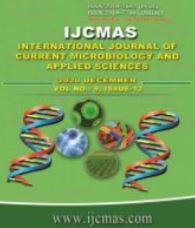


 National Academy of Agricultural Sciences (NAAS)
National Academy of Agricultural Sciences (NAAS)

|
PRINT ISSN : 2319-7692
Online ISSN : 2319-7706 Issues : 12 per year Publisher : Excellent Publishers Email : editorijcmas@gmail.com / submit@ijcmas.com Editor-in-chief: Dr.M.Prakash Index Copernicus ICV 2018: 95.39 NAAS RATING 2020: 5.38 |
The field experiment was carried out at Research cum Instructional Farm, Indira Gandhi Krishi Vishwavidyalaya Raipur (C.G.) during Kharif season of 2017-18 to evaluate the Response of drip fertigation on growth, yield and nutrient uptake of soybean in vertisols. There were eight treatment T1- 75% RDF through fertigation, T2- 100% RDF through fertigation, T3- 125% RDF through fertigation, T4 - 75% RDF (25 % Basal + 75 % through fertigation), T5-100% RDF (25 % Basal+ 75 % through fertigation), T6- 125% RDF (25 % Basal + 75 % through fertigation), T7-100% RDF through conventional application with drip irrigation, T8- No fertilization with conventional irrigation. The results of experiment indicated that maximum growth were observed with application of 125% RDF through fertigation (T3), however application of 100% RDF through fertigation (T2) produced significantly maximum seed yield (26.89 q ha-1),while maximum stover yield (32.77q ha-1) produced with the application of 125% RDF through fertigation (T3) In terms of N, P and K uptake (kg ha-1) in seed (132.85, 17.59 and 126.44 kg ha-1) and stover (105.33, 8.66 and 96.80 kg ha-1) by soybean crop was highest with the application of 100% RDF through fertigation (T2). N, P and K content %in seed (5.39, 0.54 and 4.77 %) and stover (3.50, 0.27 and 3.14 %) of soybean found significantly higher with the application of125% RDF through fertigation (T3).The minimum, seed yield (9.77 q ha-1) and stover yield (18.06 q ha-1), nutrient content and uptake were observed under no fertigation with conventional irrigation (T8).
 |
 |
 |
 |
 |